Redirection and Protocol Mechanisms in Content Delivery Network-Edge Servers for Adaptive Video Streaming
Abstract
1. Introduction
1.1. Research Contributions
- For proposing hybrid protocols by preparing a case study on selecting optimal protocols for replicating adaptive video streaming content over the edge networks’ servers, it is important to consider the following factors: The network topology of the edge servers is a crucial factor in determining which protocol is the most suitable. For example, if the edge servers are located in different geographical regions, a protocol that can handle large distances and network congestion would be more appropriate. The protocol chosen should be able to handle adaptive streaming and provide high-quality video playback. The chosen protocol should be able to reduce latency as much as possible. The protocol should be able to efficiently use the available bandwidth to deliver video content to users. A thorough evaluation and testing of each protocol in the edge network environment are necessary to determine the optimal protocol.
- A redirection algorithm based on Cuckoo search can be proposed to provide an accurate redirecting process of selected edge servers to end-users. The basic idea behind this algorithm is to use the Cuckoo search optimization technique to determine the optimal location of the edge servers that will provide the best performance for the end-users. The Cuckoo search algorithm can be used to find the optimal solution by mimicking the behavior of cuckoos in the natural world. In this algorithm, the edge servers are seen as cuckoos and the optimal location of the edge servers is seen as the best nest. The algorithm uses a combination of random walk and Levy flight, which is inspired by the random searching behavior of cuckoos, to explore the solution space and find the optimal location of the edge servers.
- The applied protocols mechanism and redirection algorithm can further improve the service of QoE for adaptive video streaming.
1.2. Background and Literature Review
1.2.1. Adaptive Video Streaming and CDN
1.2.2. Content Replication Based on Push Protocols
1.2.3. Redirection Algorithm
2. Research Methodology
2.1. Problem Statement
2.2. Problem Solutions
2.3. General System
2.3.1. Server Distribution Mechanism
2.3.2. Edge Servers
2.3.3. Network Connection and Quality of Service (QoS)
2.3.4. End-Users
2.4. Content Transfer Protocols
2.4.1. FASP (Fast and Secure Protocol)
2.4.2. FCP (File Catalyst Protocol)
2.4.3. Signiant
2.5. Redirection Algorithm
| Algorithm 1. Modified Cuckoo Search Algorithm |
| 1: Objective function f(X), X= (f(x1, x2, …, xd)T 2: Generate initial population of n host nests Xi (i = l, 2, …, n) 3: While t < Max iterations do 4: Get a cuckoo randomly by Levy flights 5: Evaluate its quality/fitness Fi 6: Choose a nest among n (say, j) randomly 7: If Fi > Fj then 8: Replace j by the new solution; 9: End If 10: Get (max_Throughput, min_cpu, min_memory) 11: If max_Throughput [i] > 95 then 12: max_Throughput [j] = max_Throughput [i] 13: Else If min_cpu [i] < 60 then 14: min_cpu [j] = min_cpu [i] 15: Else If min_memory [i] < 40 16: min_memory [j] = min_memory [i] 17: End If 18: Keep the best solutions |
3. Experimental Results
3.1. Optimal Push-Protocol Selection
3.2. Cuckoo Search Algorithm Based Optimal Edge Server Redirection
4. Results and Discussion
5. Conclusions and Future Outlook
Author Contributions
Funding
Institutional Review Board Statement
Informed Consent Statement
Data Availability Statement
Acknowledgments
Conflicts of Interest
References
- Wang, Z.; Huang, J.; Rose, S. Evolution and challenges of DNS-based CDNs. Digit. Commun. Netw. 2018, 4, 235–243. [Google Scholar] [CrossRef] [PubMed]
- Baccaglini, E.; Grangetto, M.; Quacchio, E.; Zezza, S. A study of an hybrid CDN–P2P system over the PlanetLab network. Signal Process. Image Commun. 2012, 27, 430–437. [Google Scholar] [CrossRef]
- He, H.; Feng, Y.; Li, Z.; Zhu, Z.; Zhang, W.; Cheng, A. Dynamic load balancing technology for cloud-oriented CDN. Comput. Sci. Inf. Syst. 2015, 12, 765–786. [Google Scholar] [CrossRef]
- Sandvine Report, Sandvine Intelligent Broadband Networks. Available online: https://www.sandvine.com/trends/globalinternetphenomena/ (accessed on 10 January 2023).
- Cisco White Paper, Cisco Visual Networking Index: Forecast and Methodology, 2018–2023. Tech. Rep. Cisco. 2023. Available online: http://bit.ly/bwGY7L (accessed on 10 January 2023).
- Lin, C.-F.; Leu, M.-C.; Chang, C.-W.; Yuan, S.-M. The Study and Methods for Cloud Based CDN. In Proceedings of the 2011 International Conference on Cyber-Enabled Distributed Computing and Knowledge Discovery, Beijing, China, 10–12 October 2011; pp. 469–475. [Google Scholar]
- Seeliger, R.; Silhavy, D.; Arbanowski, S. Dynamic Ad-Insertion and Content Orchestration Workflows through Manifest Manipulation in HLS and MPEG-DASH. In Proceedings of the 2017 IEEE Conference on Communications and Network Security (CNS), Las Vegas, NV, USA, 9–11 October 2017; pp. 450–455. [Google Scholar]
- Taha, M.; Ali, A.; Lloret, J.; Gondim, P.R.L.; Canovas, A. An automated model for the assessment of QoE of adaptive video streaming over wireless networks. Multimed. Tools Appl. 2021, 80, 26833–26854. [Google Scholar] [CrossRef]
- Taha, M.; Canovas, A.; Lloret, J.; Ali, A. A QoE adaptive management system for high definition video streaming over wireless networks. Telecommun. Syst. 2021, 77, 63–81. [Google Scholar] [CrossRef]
- Anjum, N.; Karamshuk, D.; Shikh-Bahaei, M.; Sastry, N. Survey on peer-assisted content delivery networks. Comput. Netw. 2017, 116, 79–95. [Google Scholar] [CrossRef]
- Wan, S.; Ding, S.; Chen, C. Edge computing enabled video segmentation for real-time traffic monitoring in internet of vehicles. Pattern Recognit. 2022, 121, 108146. [Google Scholar] [CrossRef]
- Passarella, A. A survey on content-centric technologies for the current Internet: CDN and P2P solutions. Comput. Commun. 2012, 35, 1–32. [Google Scholar] [CrossRef]
- Taha, M. A Novel CDN Testbed for Fast Deploying HTTP Adaptive Video Streaming. In Proceedings of the 9th EAI International Conference on Mobile Multimedia Communications, Xi’an, China, 18–20 June 2016; pp. 65–71. [Google Scholar]
- Hammershøj, A.; Nowak, A.; Hansen, J.K.B.; Stefanović, Č. Next-Generation OTT Distribution Architecture Supporting Multicast-Assisted ABR (mABR) and HTTP/3 Over QUIC. SMPTE Motion Imaging J. 2022, 131, 31–39. [Google Scholar] [CrossRef]
- Hayes, B.; Chang, Y.; Riley, G. Adaptive Bitrate Video Delivery Using HTTP/2 over MPTCP Architecture. In Proceedings of the 2017 13th International Wireless Communications and Mobile Computing Conference (IWCMC), Valencia, Spain, 26–30 June 2017; pp. 68–73. [Google Scholar]
- Ghotbou, A.; Khansari, M. Comparing application layer protocols for video transmission in IoT low power lossy networks: An analytic comparison. Wirel. Netw. 2021, 27, 269–283. [Google Scholar] [CrossRef]
- Roome, W.; Yang, Y. RFC 8895 Application-Layer Traffic Optimization (ALTO) Incremental Updates Using Server-Sent Events (SSE); Internet Engineering Task Force (IETF): Fremont, CA, USA, 2020. [Google Scholar]
- Sitorus, S.P.; Hasibuan, E.R.; Rohani, R. Analysis performance of content delivery network by used Rateless Code method. Sink. J. Dan Penelit. Tek. Inform. 2022, 7, 2348–2359. [Google Scholar] [CrossRef]
- Liu, R.; Yuan, X.; Xu, J.; Zeng, Y.; Cao, M.; Liu, J.; Xu, L.; Fang, Q. A novel server selection approach for mobile cloud streaming service. Simul. Model. Pract. Theory 2015, 50, 72–82. [Google Scholar] [CrossRef]
- Andjamba, T.S.; Lusilao Zodi, G.-A.L. A Load Balancing Protocol for Improved Video on Demand in SDN-Based Clouds. In Proceedings of the 2023 17th International Conference on Ubiquitous Information Management and Communication (IMCOM), Seoul, Republic of Korea, 3–5 January 2023; pp. 1–6. [Google Scholar]
- Wang, Y.; Wang, H. CDN Service Detection Method Based on Machine Learning. In Big Data Management and Analysis for Cyber Physical Systems: Selected Papers of BDET 2022; Springer International Publishing: Cham, Switzerland, 2022; pp. 161–174. [Google Scholar]
- Nour, B.; Khelifi, H.; Moungla, H.; Hussain, R.; Guizani, N. A distributed cache placement scheme for large-scale information-centric networking. IEEE Netw. 2020, 34, 126–132. [Google Scholar] [CrossRef]
- Farahani, R.; Amirpour, H.; Tashtarian, F.; Bentaleb, A.; Timmerer, C.; Hellwagner, H.; Zimmermann, R. RICHTER: Hybrid P2P-CDN Architecture for Low Latency Live Video Streaming. In Proceedings of the 1st Mile-High Video Conference, Denver, CO, USA, 1–3 March 2022; pp. 87–88. [Google Scholar]
- Apostolopoulos, J.G.; Tan, W.-T.; Wee, S.J. Performance of a Multiple Description Streaming Media Content Delivery Network. In Proceedings of the International Conference on Image Processing, Rochester, NY, USA, 22–25 September 2002; Volume 2, p. p. II. [Google Scholar]
- Peñaherrera-Pulla, O.S.; Baena, C.; Fortes, S.; Baena, E.; Barco, R. Measuring key quality indicators in cloud gaming: Framework and assessment over wireless networks. Sensors 2021, 21, 1387. [Google Scholar] [CrossRef] [PubMed]
- Khansoltani, A.; Jamali, S.; Fotohi, R. A Request Redirection Algorithm in Content Delivery Network: Using PROMETHEE Approach. Wirel. Pers. Commun. 2022, 126, 1145–1175. [Google Scholar] [CrossRef]
- Boros, T.; Bencel, R.; Kotuliak, I. Transparent Redirections in Content Delivery Networks. Appl. Sci. 2019, 9, 5418. [Google Scholar] [CrossRef]
- Murata, K.T.; Pavarangkoon, P.; Yamamoto, K.; Nagaya, Y.; Mizuhara, T.; Takaki, A.; Muranaga, K.; Kimura, E.; Ikeda, T.; Ikeda, K.; et al. A Quality Measurement Tool for High-Speed Data Transfer in Long Fat Networks. In Proceedings of the 2016 24th International Conference on Software, Telecommunications and Computer Networks (SoftCOM), Split, Croatia, 22–24 September 2016; pp. 1–5. [Google Scholar]
- File Catalyst. Available online: https://support.filecatalyst.com/index.php?/Knowledgebase/Article/View/121 (accessed on 18 October 2022).
- Signiant. Available online: https://www.signiant.com/technology/signiant-platform/ (accessed on 20 October 2022).
- Fister, I., Jr.; Fister, D.; Fister, I. A comprehensive review of cuckoo search: Variants and hybrids. Int. J. Math. Model. Numer. Optim. 2013, 4, 387–409. [Google Scholar]
- Yang, Q.; Huang, H.; Zhang, J.; Gao, H.; Liu, P. A collaborative cuckoo search algorithm with modified operation mode. Eng. Appl. Artif. Intell. 2023, 121, 106006. [Google Scholar] [CrossRef]
- Yang, Q.; Gao, H.; Dong, N.; Liu, P. An elitist cuckoo search algorithm for combined heat and power economic dispatch. Int. J. Prod. Res. 2023, 1–21. [Google Scholar] [CrossRef]
- BigBuckBunny. Available online: https://peach.blender.org/download/ (accessed on 10 November 2022).
- MPEG-DASH: Dynamic Adaptive Streaming Over HTTP Explained. Available online: https://www.wowza.com/blog/mpeg-dash-dynamic-adaptive-streaming-over-http (accessed on 10 December 2022).
- MPEG-DASH Content Generation with MP4Box Dash and x264. Available online: https://bitmovin.com/mp4box-dash-content-generation-x264/ (accessed on 10 September 2022).
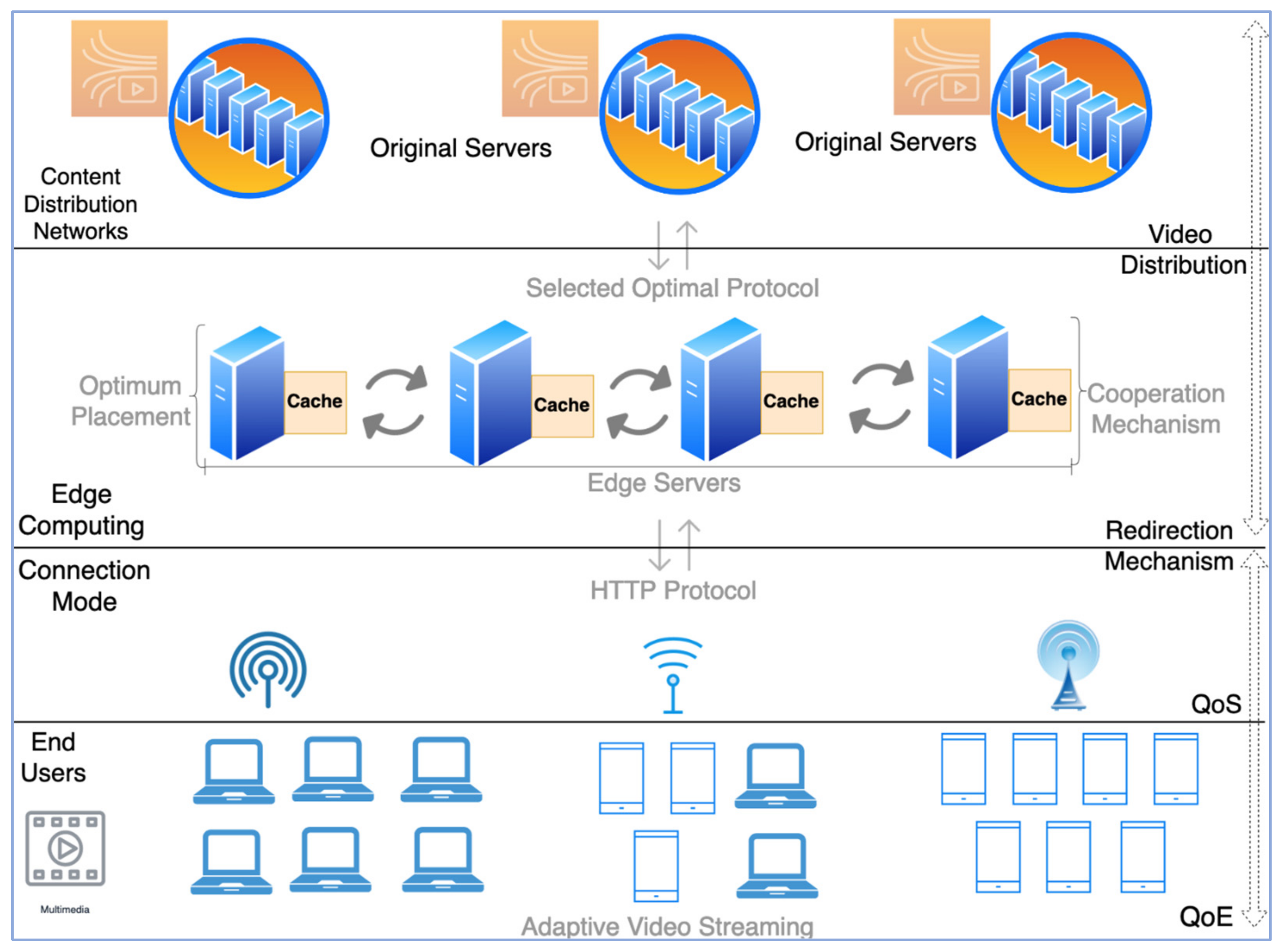
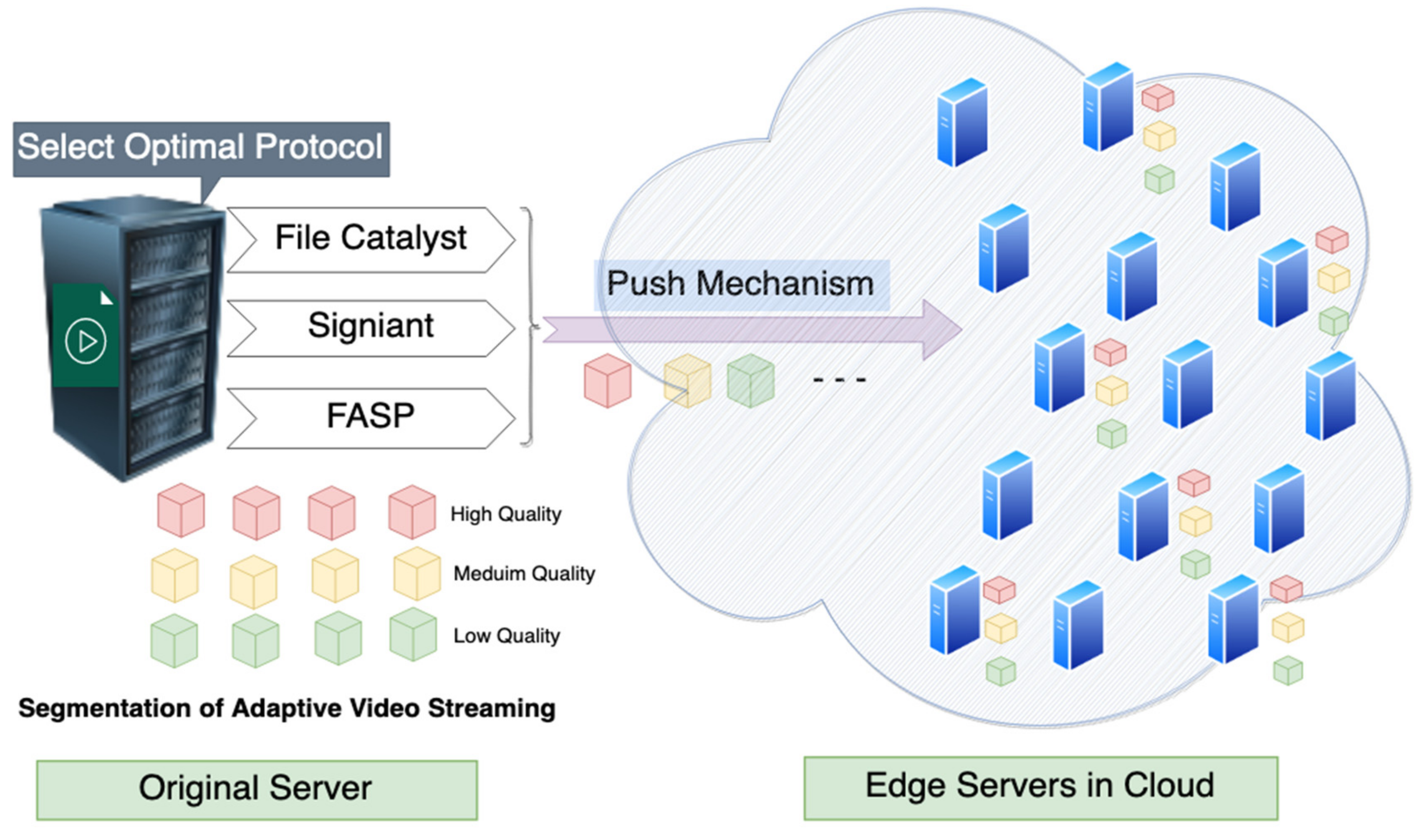
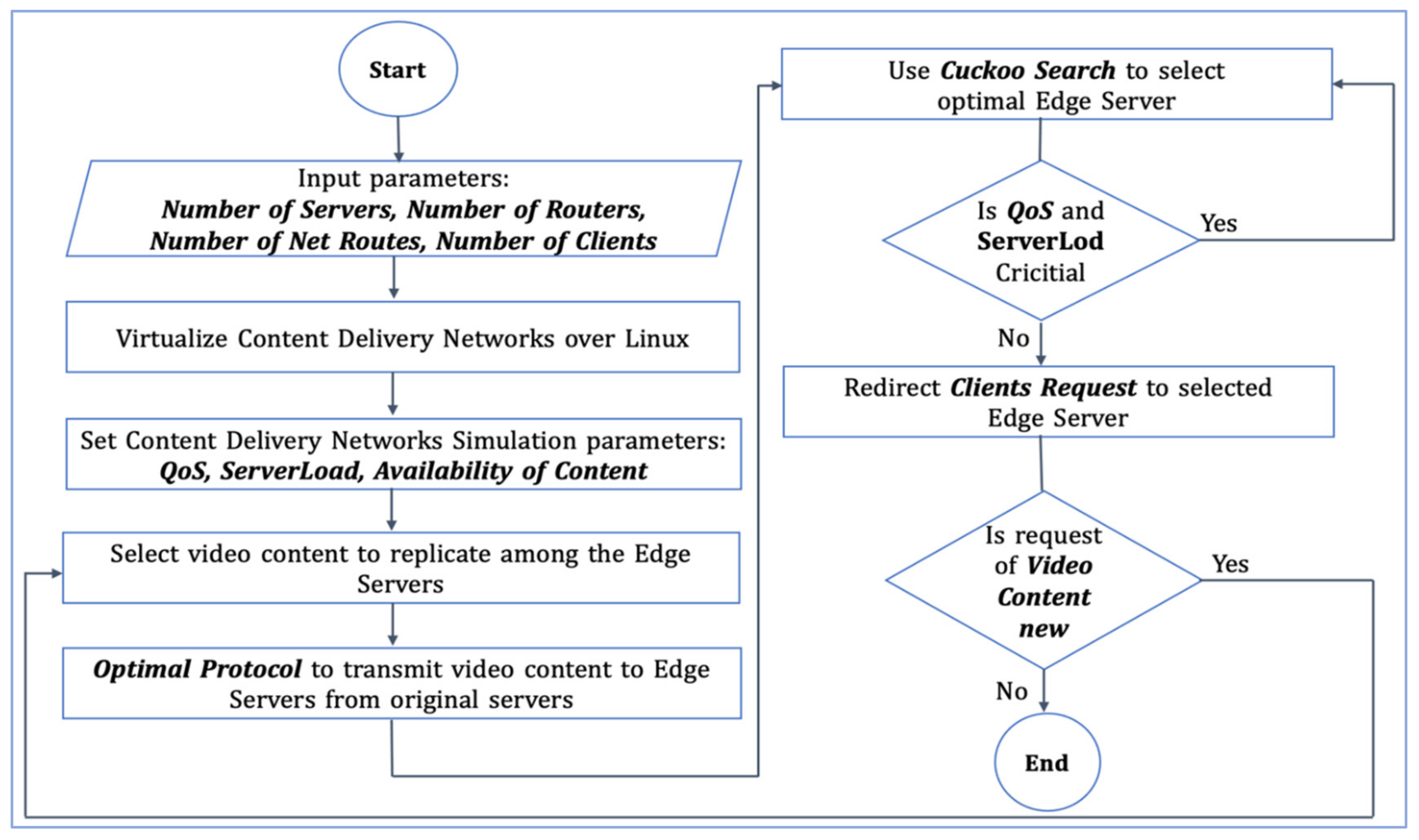
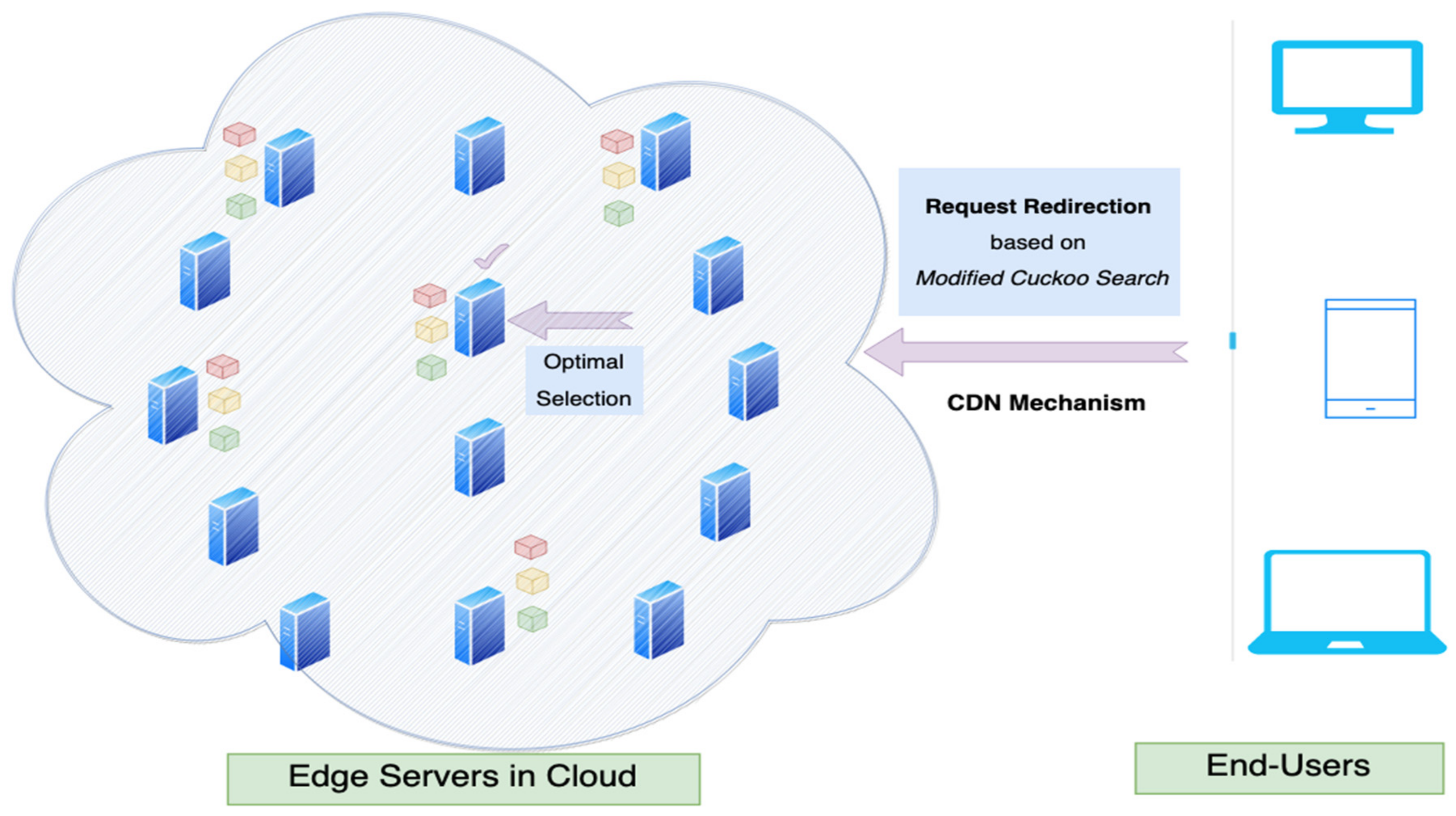
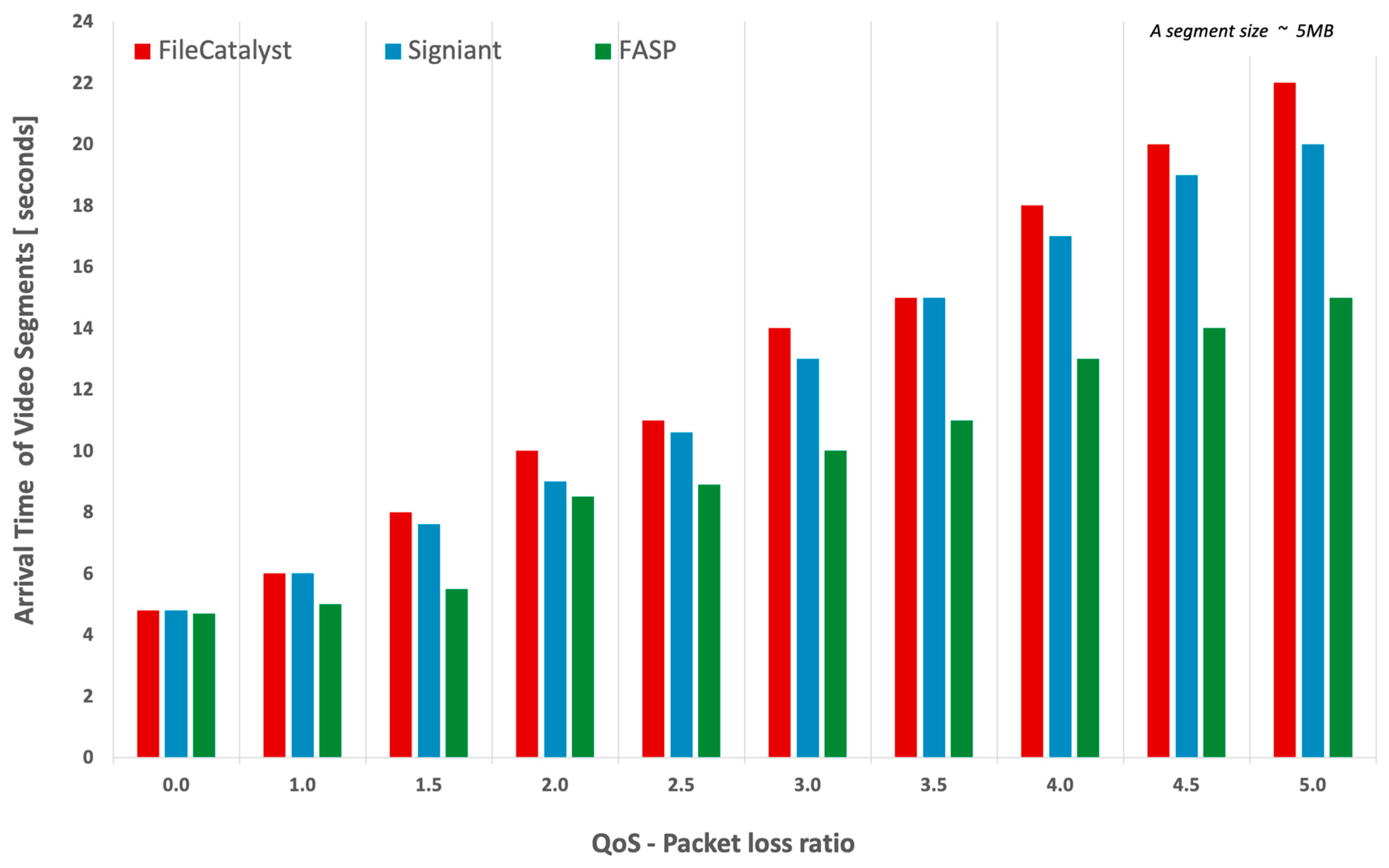
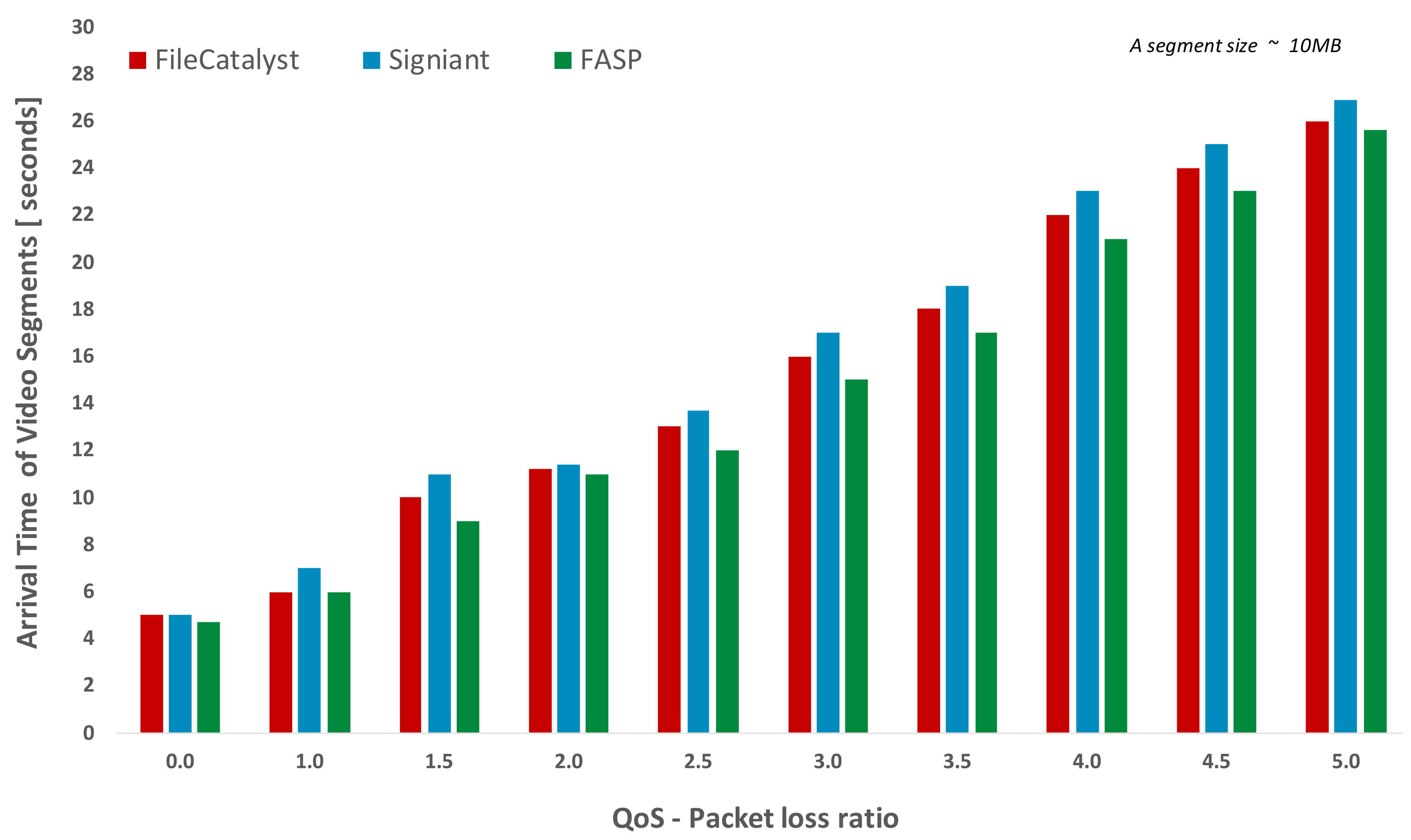
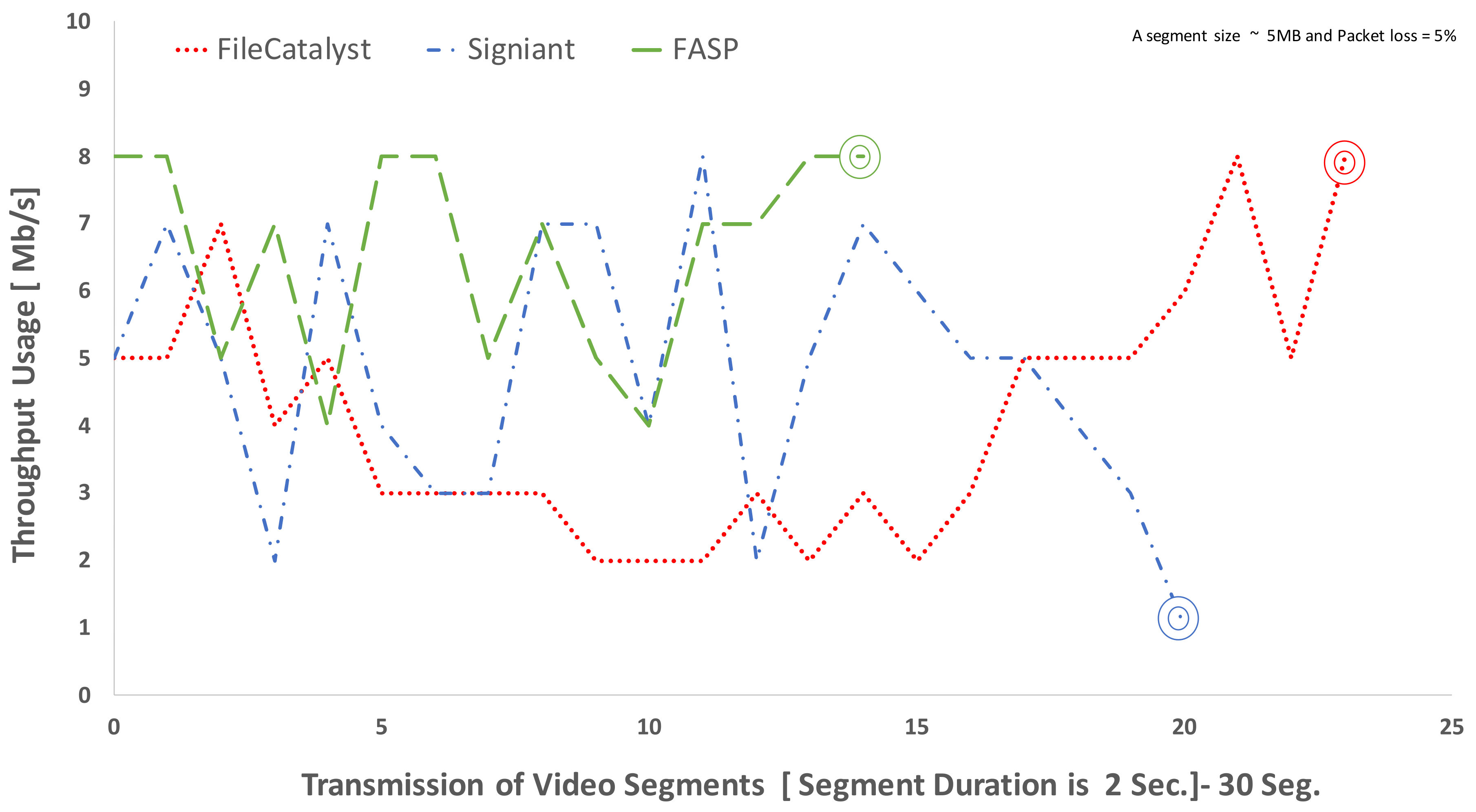
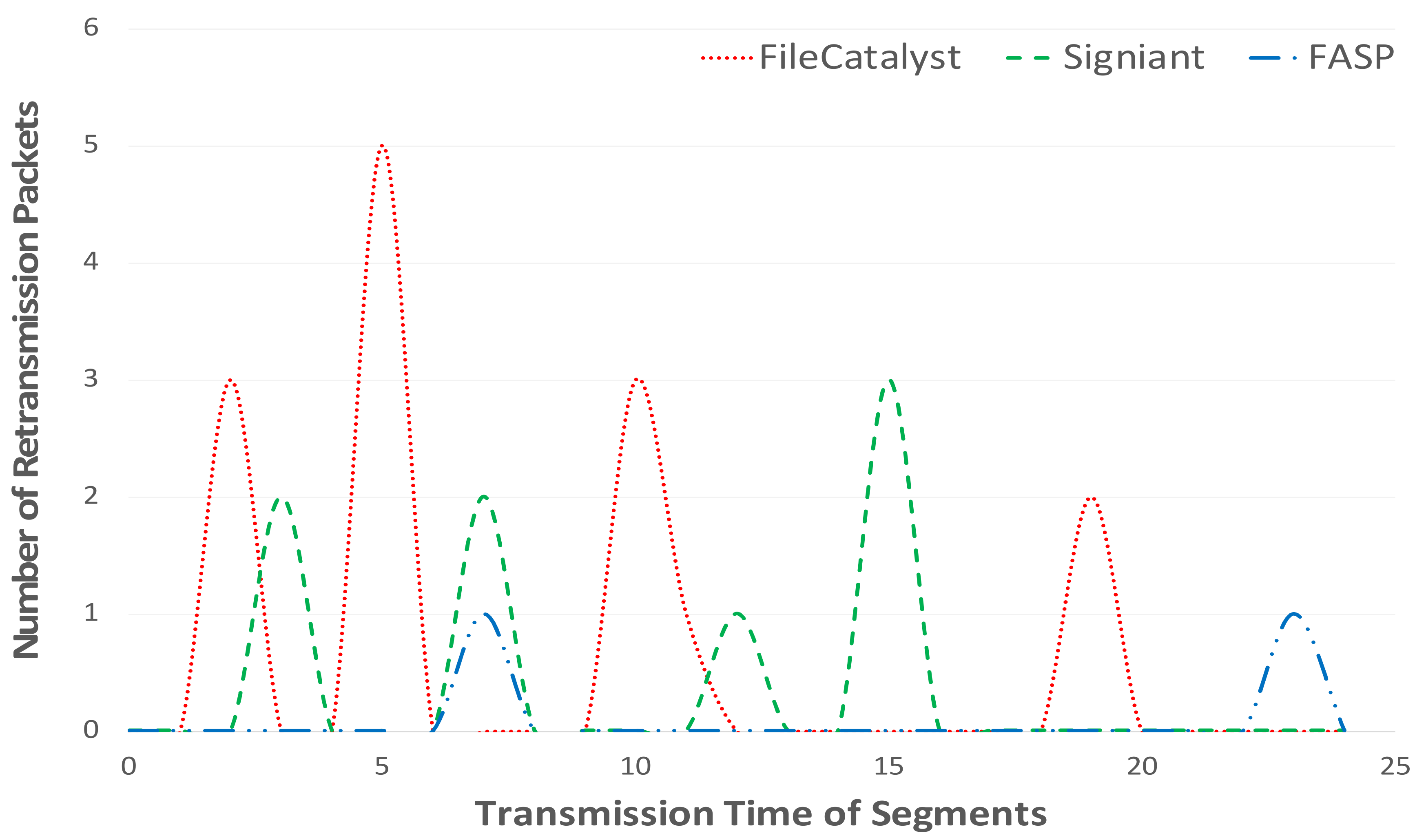

| Feature | HTTP/2 Server Push | WebSockets | QUIC | Server-Sent Events (SSE) |
|---|---|---|---|---|
| Connection Type | Unidirectional | Bidirectional | Bidirectional | Unidirectional |
| Connection Establishment | TCP connection | TCP connection | UDP connection | TCP connection |
| Data Transfer | Pushed resources | Real-time updates | Real-time updates | Real-time updates |
| Multiple Resources | Yes | No | Yes | No |
| Browser Compatibility | Widely supported | Widely supported | Limited support | Widely supported |
| Server Compatibility | Requires HTTP/2 server | Requires server-side WebSocket support | Requires QUIC-enabled server | Requires SSE server support |
| Performance | Faster than HTTP/1.1 | Low latency, low overhead | Low latency, reduced round trips | Low overhead, reduced latency |
| Use Cases | Static resources, application resources | Real-time applications, gaming, chat | Streaming media, real-time applications | Real-time updates, news feeds, stock tickers |
| Parameter | Value |
|---|---|
| Video size | 270 MB |
| Streaming time | 60 s |
| Total number of clips | 2 |
| Channel used | Wi-Fi and Wire Connection |
| Channel bandwidth | Shaped to varied Mbps |
| Packet size | 1500 bytes (MTU) |
| Edge Server | CPU Usage | Memory Usage | Connected Users | RoutesNumber | Throughput | Delay | Packet Loss | Jitter |
|---|---|---|---|---|---|---|---|---|
| 1 | 62 | 72 | 4 | 3 | 97 | 2.656 | 5.55904 | 0.203345 |
| 2 | 87 | 76 | 35 | 1 | 92 | 1.583 | 7.04032 | 2.6157047 |
| 3 | 94 | 53 | 14 | 2 | 93 | 2.131 | 1.68278 | 0.8825650 |
| 4 | 67 | 76 | 54 | 3 | 92 | 3.465 | 9.92742 | 0.7340152 |
| 5 | 87 | 51 | 71 | 2 | 99 | 2.636 | 0.41238 | 2.3412498 |
| 6 | 80 | 46 | 25 | 3 | 96 | 2.305 | 8.50534 | 1.7710537 |
| 7 | 71 | 71 | 92 | 3 | 96 | 0.626 | 6.82522 | 3.7686835 |
| 8 | 67 | 58 | 7 | 2 | 92 | 1.770 | 1.95282 | 1.0805983 |
| 9 | 88 | 44 | 33 | 3 | 94 | 3.156 | 5.61545 | 1.3142494 |
| 10 | 88 | 72 | 21 | 3 | 95 | 2.672 | 0.40681 | 1.7904575 |
| 11 | 79 | 58 | 51 | 3 | 94 | 5.163 | 5.02267 | 1.1969529 |
| 12 | 58 | 66 | 91 | 1 | 95 | 2.019 | 1.19856 | 0.7944980 |
| 13 | 86 | 38 | 69 | 1 | 93 | 3.677 | 1.91542 | 3.4175009 |
| 14 | 50 | 77 | 77 | 3 | 90 | 1.064 | 4.72987 | 2.1251593 |
| 15 | 55 | 75 | 40 | 2 | 91 | 1.886 | 1.02411 | 3.3074925 |
| 16 | 64 | 56 | 96 | 1 | 99 | 5.124 | 0.04153 | 0.7678096 |
| 17 | 85 | 32 | 24 | 3 | 95 | 2.356 | 1.74254 | 1.6210663 |
| 18 | 63 | 74 | 16 | 1 | 95 | 0.738 | 2.77767 | 1.0086972 |
| 19 | 67 | 76 | 32 | 3 | 90 | 2.719 | 0.41380 | 0.2929830 |
| 20 | 86 | 56 | 59 | 2 | 96 | 5.386 | 0.38923 | 1.2865177 |
| 21 | 72 | 77 | 53 | 2 | 98 | 2.293 | 7.43302 | 0.5658469 |
| 22 | 71 | 66 | 0 | 1 | 92 | 3.923 | 6.42011 | 0.7887767 |
| 23 | 85 | 70 | 81 | 3 | 92 | 3.178 | 4.84003 | 0.9049112 |
| 24 | 90 | 56 | 91 | 2 | 92 | 0.496 | 7.25845 | 0.9695515 |
| 25 | 65 | 77 | 54 | 1 | 98 | 3.210 | 9.74832 | 1.3263711 |
| 26 | 68 | 67 | 53 | 1 | 93 | 2.936 | 2.00207 | 0.6449393 |
| 27 | 69 | 59 | 41 | 3 | 92 | 5.241 | 9.91450 | 4.5584150 |
| 28 | 53 | 74 | 98 | 1 | 92 | 2.225 | 5.59221 | 0.8731677 |
| 29 | 94 | 76 | 76 | 1 | 95 | 3.547 | 7.49273 | 0.7943601 |
| 30 | 71 | 48 | 43 | 3 | 93 | 5.543 | 9.72444 | 0.7880591 |
| 31 | 45 | 67 | 79 | 2 | 97 | 4.983 | 4.78968 | 0.9317921 |
| 32 | 61 | 34 | 0 | 1 | 99 | 3.951 | 2.09689 | 2.2209607 |
| 33 | 95 | 61 | 3 | 1 | 92 | 1.471 | 9.95664 | 2.6814748 |
| 34 | 59 | 43 | 77 | 3 | 97 | 1.185 | 5.76176 | 2.0959199 |
| 35 | 94 | 57 | 80 | 1 | 95 | 4.097 | 8.46127 | 0.4377711 |
| 36 | 55 | 35 | 77 | 3 | 98 | 3.050 | 2.04565 | 0.5642432 |
| 37 | 79 | 52 | 39 | 1 | 96 | 0.940 | 6.43975 | 1.7110371 |
| 38 | 77 | 55 | 12 | 1 | 99 | 4.345 | 8.64923 | 2.2476081 |
| 39 | 49 | 58 | 3 | 3 | 90 | 1.459 | 0.70297 | 1.9571320 |
| 40 | 85 | 43 | 17 | 3 | 95 | 4.182 | 9.10534 | 3.9156667 |
| 41 | 54 | 30 | 100 | 3 | 99 | 1.562 | 5.85966 | 2.2277996 |
| 42 | 57 | 31 | 38 | 3 | 90 | 1.383 | 7.79804 | 0.6399891 |
| 43 | 61 | 40 | 57 | 3 | 92 | 0.169 | 1.41964 | 0.621365 |
| 44 | 95 | 50 | 10 | 3 | 94 | 4.521 | 8.38024 | 0.4518034 |
| 45 | 55 | 30 | 38 | 1 | 98 | 1.536 | 4.55761 | 3.0727309 |
| 46 | 58 | 74 | 55 | 1 | 94 | 5.432 | 7.89317 | 0.1484519 |
| 47 | 71 | 44 | 93 | 3 | 91 | 5.090 | 9.54736 | 3.9396016 |
| 48 | 56 | 49 | 13 | 2 | 92 | 5.114 | 0.23758 | 0.7929116 |
| 49 | 87 | 60 | 61 | 2 | 99 | 4.302 | 7.56559 | 3.6293776 |
| 50 | 76 | 72 | 11 | 3 | 93 | 1.994 | 4.94734 | 1.1073077 |
| 51 | 95 | 73 | 22 | 1 | 90 | 1.247 | 4.88104 | 2.8503866 |
| 52 | 80 | 61 | 36 | 3 | 94 | 2.839 | 5.09008 | 0.4079483 |
| 53 | 54 | 42 | 61 | 2 | 98 | 5.828 | 9.78237 | 2.9530578 |
| 54 | 50 | 77 | 69 | 1 | 96 | 1.023 | 9.43731 | 2.8074353 |
| 55 | 68 | 34 | 73 | 3 | 89 | 3.606 | 4.18095 | 2.7206562 |
| 56 | 53 | 62 | 17 | 3 | 91 | 3.304 | 4.35364 | 1.7564632 |
| 57 | 51 | 71 | 92 | 1 | 96 | 2.048 | 5.14230 | 4.7477940 |
| 58 | 53 | 52 | 64 | 1 | 90 | 5.603 | 7.75086 | 0.7668703 |
| 59 | 95 | 26 | 45 | 1 | 94 | 5.113 | 0.34248 | 0.3609865 |
| 60 | 77 | 38 | 29 | 2 | 97 | 1.000 | 1.30531 | 0.8615625 |
| 61 | 83 | 76 | 47 | 3 | 89 | 0.566 | 1.78553 | 0.8100614 |
| 62 | 92 | 40 | 49 | 2 | 94 | 4.282 | 1.61013 | 2.9607700 |
| 63 | 56 | 50 | 88 | 3 | 93 | 0.918 | 4.88269 | 1.1687555 |
| 64 | 48 | 56 | 32 | 2 | 95 | 1.460 | 7.16725 | 0.2467752 |
| 65 | 51 | 45 | 69 | 3 | 89 | 1.382 | 3.55064 | 2.4037668 |
| 66 | 50 | 72 | 83 | 1 | 91 | 4.348 | 1.54139 | 0.8550973 |
| 67 | 69 | 58 | 39 | 2 | 91 | 5.163 | 4.94259 | 2.3305362 |
| 68 | 62 | 72 | 30 | 3 | 95 | 1.566 | 0.56683 | 4.0479767 |
| 69 | 56 | 58 | 11 | 1 | 90 | 2.740 | 0.24556 | 0.7166811 |
| 70 | 95 | 67 | 84 | 2 | 93 | 0.643 | 2.38984 | 2.7502833 |
| 71 | 85 | 32 | 31 | 3 | 97 | 3.064 | 3.26898 | 0.0149043 |
| 72 | 94 | 26 | 10 | 1 | 92 | 3.995 | 7.38077 | 2.2560714 |
| 73 | 62 | 68 | 60 | 1 | 97 | 2.695 | 2.52409 | 1.9707387 |
| 74 | 54 | 77 | 14 | 3 | 89 | 4.909 | 8.83199 | 6.6727779 |
| 75 | 90 | 75 | 67 | 3 | 94 | 3.446 | 7.68378 | 0.6288889 |
| 76 | 66 | 47 | 46 | 1 | 95 | 0.255 | 9.41012 | 0.4337908 |
| 77 | 79 | 65 | 99 | 3 | 99 | 0.402 | 7.53776 | 0.7917249 |
| 78 | 54 | 47 | 6 | 3 | 94 | 1.287 | 9.06339 | 3.3683369 |
| 79 | 87 | 77 | 0 | 2 | 92 | 3.834 | 0.01897 | 3.9577402 |
| 80 | 82 | 37 | 18 | 3 | 97 | 2.746 | 5.04830 | 6.4923354 |
| 81 | 48 | 70 | 4 | 2 | 98 | 5.877 | 5.54697 | 4.4193902 |
| 82 | 94 | 53 | 69 | 1 | 94 | 0.712 | 2.99590 | 4.8421968 |
| 83 | 79 | 65 | 66 | 1 | 90 | 4.759 | 1.92578 | 1.2787296 |
| 84 | 58 | 38 | 91 | 3 | 92 | 2.035 | 9.33461 | 0.4830292 |
| 85 | 87 | 59 | 60 | 2 | 98 | 1.000 | 0.32271 | 1.4024168 |
| 86 | 61 | 46 | 46 | 1 | 94 | 2.933 | 7.25489 | 0.6195066 |
| 87 | 74 | 33 | 25 | 1 | 93 | 2.196 | 9.27590 | 3.0574970 |
| 88 | 85 | 62 | 29 | 2 | 97 | 2.485 | 7.24906 | 1.1583382 |
| 89 | 69 | 50 | 13 | 1 | 99 | 4.468 | 9.64836 | 0.9202245 |
| 90 | 62 | 24 | 25 | 2 | 99 | 3.997 | 5.41173 | 2.7490257 |
| 91 | 77 | 76 | 88 | 2 | 90 | 2.229 | 0.98957 | 1.2524622 |
| 92 | 76 | 64 | 65 | 1 | 98 | 5.011 | 3.17172 | 0.3187478 |
| 93 | 85 | 27 | 32 | 3 | 90 | 4.639 | 5.05382 | 0.1886412 |
| 94 | 65 | 73 | 29 | 2 | 94 | 2.755 | 0.57919 | 4.6637723 |
| 95 | 76 | 45 | 11 | 2 | 89 | 0.791 | 4.63834 | 1.4766862 |
| 96 | 68 | 51 | 48 | 3 | 90 | 0.000 | 2.35439 | 0.0833337 |
| 97 | 77 | 46 | 71 | 3 | 92 | 2.839 | 6.59114 | 2.2687105 |
| 98 | 89 | 35 | 87 | 1 | 89 | 1.735 | 6.57669 | 3.1555948 |
| 99 | 63 | 49 | 87 | 1 | 95 | 2.106 | 4.25138 | 3.0403892 |
| 100 | 53 | 51 | 37 | 2 | 89 | 4.572 | 8.05649 | 2.2761992 |
Disclaimer/Publisher’s Note: The statements, opinions and data contained in all publications are solely those of the individual author(s) and contributor(s) and not of MDPI and/or the editor(s). MDPI and/or the editor(s) disclaim responsibility for any injury to people or property resulting from any ideas, methods, instructions or products referred to in the content. |
© 2023 by the authors. Licensee MDPI, Basel, Switzerland. This article is an open access article distributed under the terms and conditions of the Creative Commons Attribution (CC BY) license (https://creativecommons.org/licenses/by/4.0/).
Share and Cite
Taha, M.; Ali, A. Redirection and Protocol Mechanisms in Content Delivery Network-Edge Servers for Adaptive Video Streaming. Appl. Sci. 2023, 13, 5386. https://doi.org/10.3390/app13095386
Taha M, Ali A. Redirection and Protocol Mechanisms in Content Delivery Network-Edge Servers for Adaptive Video Streaming. Applied Sciences. 2023; 13(9):5386. https://doi.org/10.3390/app13095386
Chicago/Turabian StyleTaha, Miran, and Aree Ali. 2023. "Redirection and Protocol Mechanisms in Content Delivery Network-Edge Servers for Adaptive Video Streaming" Applied Sciences 13, no. 9: 5386. https://doi.org/10.3390/app13095386
APA StyleTaha, M., & Ali, A. (2023). Redirection and Protocol Mechanisms in Content Delivery Network-Edge Servers for Adaptive Video Streaming. Applied Sciences, 13(9), 5386. https://doi.org/10.3390/app13095386






